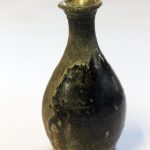You’ve read or heard it repeatedly. “This potter has grasped the artistic essence of Momoyama (1573–1603), the golden age of Japanese ceramics. And he/she has incorporated that essence in sublime works that transcend mere reproductions of Momoyama pottery. Blah blah blah.”
Unfortunately, the forgoing sort of nonsense pervades commercial and critical discourse in the world of Japanese ceramics. It begs the question as to who, anywhere in our age, has created a convincing “reproduction” of Momoyama pottery. Having failed to find anyone who has attained the essence of the Momoyama works, we can hardly swallow the notion of anyone having transcended those creations.
We encounter, in any case, only two kinds of pottery in any era: good and not so good. Let us embrace the former on its own terms, without relying on historical comparisons, and let us reject the latter on its own terms, spurning the commentators who would rationalize incompetence as transcendence.
Fortunately, superior works of pottery from every era are on view readily in museums and galleries. Those works are the best teachers for anyone seriously interested in coming to terms with Japan’s ceramic tradition. Before discussing any potter in connection with Momoyama or with any other era, let’s double-check that we know what we’re talking about.






